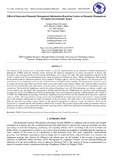Effect of Integrated Financial Management Information Reporting System on Financial Management in County Governments, Kenya
Date
2023-07-18Author
Iravonga, Jamgun Jensen
Alala, Benedict Ondiek
Maingi, Muli
Ngala, Consolata
Metadata
Show full item recordAbstract
The purpose of the research was to determine whether or not the implementation of the Integrated Financial Management Information (IFMIS) financial reporting system improved the financial management of county governments in Kenya. The descriptive survey design and the causal research methodology were used for this study. The target population consisted of 302 workers working in the Treasury Department in the county governments of Kakamega, Busia, Vihiga, and Bungoma. This included 44 procurement officers, 46 internal auditors, 89 accountants, 87 finance officers, and 42 revenue officers. The selection of the 172 respondents was accomplished via the use of a method known as stratified random sampling. The questionnaire method was used to acquire the primary data. Pilot research was done to assess the content and construct validity, and Cronbach Alpha was used to determine the dependability of the information. Using descriptive and inferential statistics, an analysis of the quantitative data was carried out. The threshold of significance used in the testing of hypotheses was 0.05. The information was laid up in tables, and several models were developed. The investigation's findings indicated that the IFMIS financial reporting system substantially accounted for 42.2% of the difference in financial management across the County Governments in Western Kenya (R2 = 0.422, P = 0.000). The IFMIS financial reporting system had a significance level of P=0.05, and the unstandardized regression coefficient value was 0.836. This suggested that a change of one unit in the IFMIS financial reporting system would result in a change of 0.836 units in the financial management of county governments in Western Kenya. The study came to the conclusion that the IFMIS financial reporting system had a major impact on the financial management of Kenya's county governments, which led the researchers to conclude that the null hypothesis should not be accepted. The research suggests that county governments in Kenya should strictly adhere to the requirements of financial reporting policies, fulfill their legal duties for financial reporting, and use technology to improve their financial reporting.
URI
https://doi.org/10.51867/ajernet.4.2.6https://ajernet.net/ojs/index.php/ajernet/article/view/74
http://ir-library.mmust.ac.ke:8080/xmlui/handle/123456789/2301
Collections
- Gold Collection [1021]

